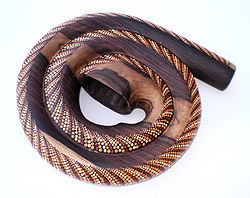- Modern didgeridoo designs
-
Modern didgeridoo designs are distinct from the traditional Australian Aboriginal didgeridoo, and are innovations recognized by musicologists.[1][2] Didgeridoo design innovation started in the late 20th Century using non-traditional materials and non-traditional shapes. The design changes include features that are similar to more familiar musical instruments like the trombone and natural horn.[1][3]
The modern didgeridoo design innovations differ from traditional authentic digeridoos because they are not made by Indigenous Australians in a traditional style and do not use Eucalyptus branches hollowed by termites.[1][4] Some didgeridoo design innovations, like the sliding didgeridoos, are also multi-tonal, unlike monotonal traditional didgeridoos.[3] Like traditional didgeridoos, modern didgeridoo innovations produce a drone sound and are classified as aerophones.
Contents
Sliding didgeridoos
The sliding didgeridoos use a telescopic mechanism to create a variable pitch instrument, and can be made from plastic, aluminium or wood.[5]
Didjeribone
Invented by didgeridoo player Charlie McMahon, the Didjeribone design is a cross between the didgeridoo and trombone, and consists of two wooden tubes placed inside the other.[2] The sliding inner tube creates nine different tones, similar to the trombone mechanism. This enables the pitch to be varied mid-song, unlike traditional didgeridoos. As a result of eliminating the monotonal aspects of traditional didgeridoos, the Didjeribone can be used in horn concertos.[3] The Didjeribone has a pitch range from high G to low B. The length is 65" extended, and 37.5" closed.[3]
Slide didge
Scott Dunbar independently created a version of the variable pitch didgeridoo instrument called the slide didge in the early 1990s. The slide didge was the world's first commercially sold variable pitch didgeridoo, and Scott later produced the world's first timber slide didge.
Travel didgeridoos
The travel didgeridoos are also called traveller didgeridoo or compact didgeridoos, indicating the compact size originally designed for portability by folding the length of the didgeridoo. They are made from wood, plastic or resin, and are usually monotonal.
Didgebox
The original "Didjbox" was invented by Marko Johnson in 1995. The first production line didgebox was released in 1999. Since then, numerous versions of didgebox have been developed, including the traveler box, obelisk box, didj flute, meditator and mindblower. The didgebox is monotonal and made in the specific keys C,D,& E.
Spiral didgeridoo
The spiral didgeridoo is also known variously as a round didgeridoo, spiral didge, spiralidoo, didgehorn or snail didgeridoo. Its spiral shape makes it more like a natural horn, and instruments are monotonal in C, C#, D, E, and F. The construction method includes splitting the wood, carving, and gluing back together to form the basic instrument.[6]
Other modern didgeridoo types
A keyed didgeridoo (having keys somewhat like those of a saxophone, allowing the performer to play melodically) was developed in the late 20th century by the U.S. didgeridoo player Graham Wiggins (stage name Dr. Didg) and used on his CDs Out of the Woods (1995) (in the track "Sun Tan") and Dust Devils (2002) (in the tracks "T'Boli" and "Sub-Aqua"). Wiggins built the unique and somewhat unwieldy instrument in 1990 at the physics workshop of Oxford University, from which he earlier obtained his Ph.D.[7]
Multi drone didgeridoos have been created by William Thoren, a U.S didgeridoo player and crafter. The construction method and technique was developed in 2008 that gives a didgeridoo the possibility to produce multiple drone notes on a single didgeridoo. The lower notes that are made would require an eight to twelve foot didgeridoo, but with this technique normal size didgeridoos can be used to make low notes that were formerly unobtainable. Through the use of a larger and rounded mouth piece two or even three drone notes can be produced on a didgeridoo.
Closed end didgeridoo
The "closed end didgeridoo" was invented by Richard Marquette in 2009. Created by leaving end opposite of mouthpiece closed. Then holes and designs are carved and drilled into the closed end for the sound to flow out.
See also
- Didgeridoo
- Natural horn
- Trombones
References
- ^ a b c Wade-Matthews, M., Thompson, W., The Encyclopedia of Music, 2004, pp184-185. ISBN 0 760 76243 0
- ^ a b Wade-Matthews,M., Illustrated Encyclopedia Musical Instruments, 2003, Lorenz Books, p95. ISBN 1 357 91086 42
- ^ a b c d Didjeribone, Australia Adlib, Radio National, Australian Broadcasting Commission [1]
- ^ Thomas, R., Brass, 2002, Heinemann Library, p.22. ISBN 0 431 13070 1
- ^ Schellberg, D., Didgeridoo: ritual origins and playing techniques, Binkey Kok, 1994, pp122-123. [2]
- ^ The Spiral Didgeridoo – A Wood Aerophone Innovation.
- ^ [3]
External links
- The Didgeridoo - A Guide [4]
Categories:- Didgeridoo players
- Natural horns
Wikimedia Foundation. 2010.

